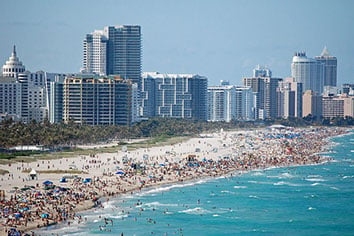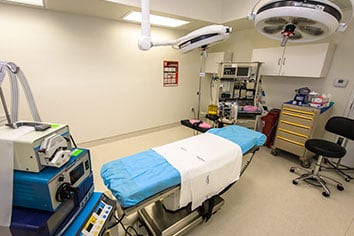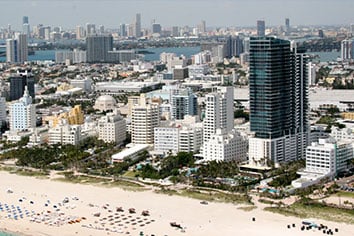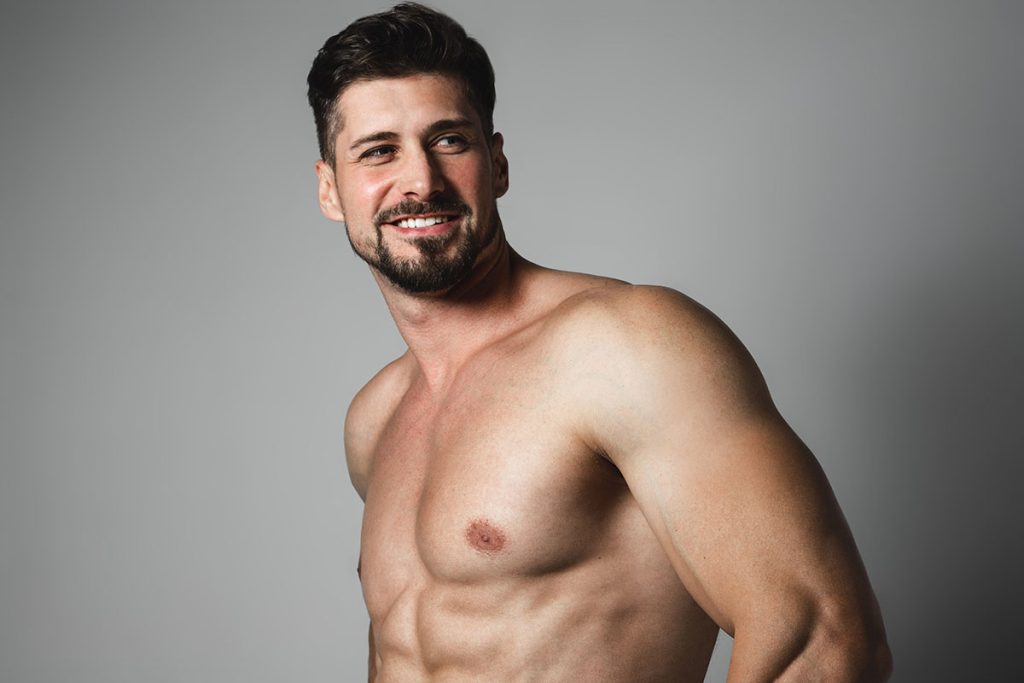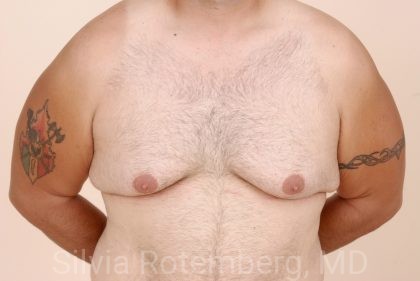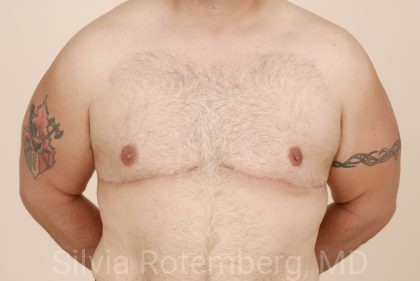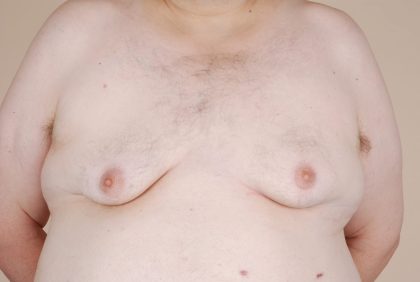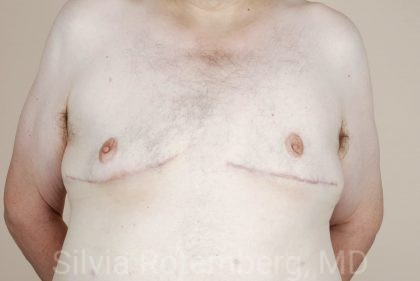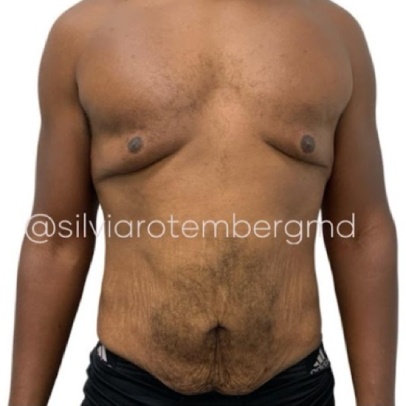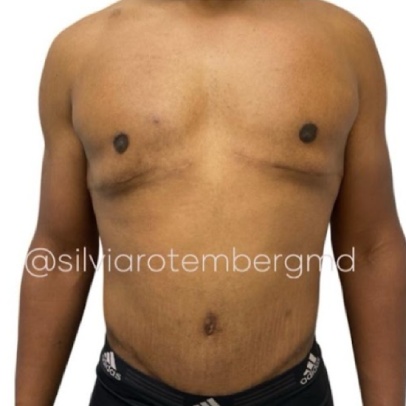Conveniently located to serve the areas of Miami and South Florida
Gynecomastia is a condition characterized by the enlargement of male breast tissue. It can often cause significant emotional distress and impact a man’s self-confidence. At Rotemberg Plastic Surgery, we understand the unique challenges faced by individuals dealing with gynecomastia, and our dedicated team is committed to providing comprehensive treatment options tailored to meet each patient’s specific needs.
Surgical intervention for gynecomastia involves removing excess breast tissue and sculpting a more masculine chest contour. Through this transformative treatment, patients can find relief from the physical and emotional discomforts of gynecomastia.
Schedule a consultation with Dr. Silvia Rotemberg at our Miami office by calling (305) 274-5170, or complete a contact form to learn more about our comprehensive approach to gynecomastia treatment.
Contents
- 1 Before and After Photos
- 2 About Gynecomastia
- 3 Getting the Help You Need
- 4 Benefits of Gynecomastia Surgery
- 5 Candidates for Gynecomastia Surgery
- 6 Personal Consultation
- 7 What Happens During Gynecomastia Surgery?
- 8 Related Body Contouring Procedures
- 9 How Much is Gynecomastia Surgery in Miami?
- 10 FAQ
- 11 References
Before and After Photos
About Gynecomastia
The enlargement of the male breast is a condition that can cause significant embarrassment and self-consciousness. As it does not conform to our idea of a traditionally masculine silhouette, the likelihood of a person experiencing anxiety and stress is higher than many other aesthetic differences a man may experience, such as love handles or excess belly fat.
Gynecomastia occurs due to hormonal imbalances, genetics, certain medications, or underlying medical conditions. And, although it may seem like something a man must struggle with secretly, a surprising number of people suffer from the condition. In fact, research studies estimate that 30% of men will experience it at some point in their lifetime. (1)
Hormonal Imbalance
Increased female hormone (estrogen) production and decreased male (androgen) responsiveness can play a significant role in the development of gynecomastia. (2) During puberty, hormonal fluctuations are common as the body undergoes significant changes. It is not uncommon for boys to experience temporary gynecomastia during this time. Typically, as puberty progresses, these hormone levels stabilize, and the breast tissue returns to its normal size. However, in some cases, the hormonal imbalance persists, leading to persistent gynecomastia.
Genetic Predisposition
Genetics undoubtedly play a role in the development of gynecomastia. Familial predisposition plays a role in the development of the condition. If someone in your family has experienced gynecomastia, there is an increased likelihood that you may also develop this condition due to shared genetic traits. It is essential to consider and evaluate the familial history while assessing the underlying causes of gynecomastia.
Medications
Medications that can cause gynecomastia include but are not limited to: (3)
- Estrogens/Estrogen-Like Drugs
- Antiandrogens
- Psychoactive Drugs
- Cytotoxic (cell-damaging) Drugs
- Cardiovascular Agents
- Antiulcer Medications
- Antibiotics
- Antiviral Medications
Medical Conditions
Medical conditions with links to gynecomastia include but are not limited to:
- Obesity
- Liver Disease
- Impaired Kidney Function
- Hyperthyroidism
Getting the Help You Need
Although non-surgical hormone treatments and lifestyle changes can resolve some cases of gynecomastia, one of the most effective treatments for the condition is male breast reduction surgery. This procedure involves the removal of excess glandular tissue and fat from the chest area, resulting in a flatter and more masculine contour. Depending on the severity of the condition, liposuction may also be performed to remove excess fat deposits. Our experienced plastic surgeon, Dr. Rotemberg, will carefully assess each patient’s individual needs and tailor the surgical approach accordingly.
Benefits of Gynecomastia Surgery
- Improved self-confidence: Gynecomastia can significantly impact a man’s self-esteem and confidence. By undergoing treatment, patients often experience a boost in self-assurance, allowing them to feel more comfortable and secure in their own bodies.
- Enhanced body image: Gynecomastia treatment helps restore a more masculine chest contour, resulting in an improved body image. This can lead to a greater sense of satisfaction with one’s appearance and overall self-image.
- Restored masculine appearance: Gynecomastia treatment aims to restore a masculine chest contour, allowing patients to achieve a more traditionally masculine appearance. This can have a significant positive impact on their overall sense of identity and self-expression.
- Reduced social anxiety: Enlarged male breasts can generate feelings of embarrassment and social anxiety. Through gynecomastia treatment, individuals can alleviate these concerns and feel more at ease in social interactions, ultimately improving their quality of life.
- Improved physical comfort: Gynecomastia can cause physical discomfort, such as pain or tenderness in the chest area. By addressing the underlying cause, patients often experience relief from these symptoms, leading to improved physical comfort.
- Enhanced ability to participate in physical activities: Enlarged male breasts can limit a person’s ability to engage in physical activities they enjoy. By undergoing gynecomastia treatment, individuals can regain their freedom to participate in sports, exercise routines, and other physical activities without discomfort or self-consciousness.
- Relief from emotional distress and psychological burden: Gynecomastia often takes a toll on a person’s mental well-being, causing emotional distress and psychological burdens. Through treatment, patients experience relief from these pressures, leading to improved emotional well-being and a renewed sense of happiness.
Finding professional help for gynecomastia is only a call or a click away. Get in touch with Rotemberg Plastic Surgery at (305) 274-5170 or complete a simple online form to connect with us and book your personal consultation with Dr. Rotemberg.
Candidates for Gynecomastia Surgery
Dr. Rotemberg understands that gynecomastia can be a difficult subject to discuss, however, she encourages men who are self-conscious about their chest to seek medical help from an experienced plastic surgeon. Good candidates for gynecomastia surgery include adolescent males experiencing excessive breast tissue growth, as well as adult men with persistent and noticeable breast enlargement. Additionally, individuals with asymmetrical or disproportionate chest appearance due to gynecomastia can benefit from this procedure.
Personal Consultation
During your personal consultation, Dr. Rotemberg will take the time to listen attentively to your specific concerns and medical history. Understanding your unique circumstances is crucial in developing an effective treatment plan, and she does so with compassionate care and understanding. She will perform a thorough assessment of your chest area, evaluating factors such as the extent of glandular tissue enlargement, excess fat deposits, and overall skin laxity.
Based on these assessments, Dr. Rotemberg will discuss your unique treatment plan with you and schedule your surgery.
What Happens During Gynecomastia Surgery?
During gynecomastia surgery, anesthesia is administered to ensure your comfort and safety. Dr. Rotemberg’s surgical approach involves removing excess glandular tissue and fat from the chest area. She will carefully sculpt the chest to create a more defined and masculine contour. Incisions are strategically placed to minimize visible scarring, and any necessary adjustments to the nipple-areolar complex can also be made during the procedure.
For patients with primarily fatty deposits causing gynecomastia, liposuction may be recommended. This minimally invasive procedure uses small incisions through which a thin tube, called a cannula, is inserted to remove excess fat. The result is a smoother, more contoured chest appearance.
Related Body Contouring Procedures
Liposuction
Liposuction is commonly used in gynecomastia treatment. It is also a surgical procedure that removes unwanted fat deposits from various other areas of the body, allowing for improved body contouring and aesthetic enhancement. It is a versatile procedure that can target areas such as the abdomen, thighs, hips, buttocks, arms, neck, and more.
Tummy Tuck
A tummy tuck, also known as abdominoplasty, is a surgical procedure that addresses excess abdominal skin and tightens the underlying muscles to create a smoother and more toned midsection. It is an effective solution for individuals who have been struggling with loose belly skin and an abdomen that has lost its firmness due to factors such as significant weight loss or simply the natural aging process.
Body Lift
A body lift after massive weight loss is a transformative surgical procedure that can help patients achieve their desired aesthetic goals. After significant weight loss, whether through diet and exercise or bariatric surgery, many individuals are left with loose, sagging skin that cannot be improved through non-surgical methods. The goal is to create a smoother, firmer, and more proportionate silhouette that reflects your hard-earned weight loss success.
How Much is Gynecomastia Surgery in Miami?
The cost of gynecomastia treatment can vary according to the specific patient’s treatment plan. For a comprehensive assessment from leading Miami plastic surgeon Dr. Silvia Rotemberg, book a personal consultation to discuss your needs by calling (305) 274-5170 or by submitting an inquiry online.
Find out more about plastic surgery procedures in Miami by reading Dr. Rotemberg’s blog.
FAQ
If I have male breasts, will I need surgery?
While surgical intervention is often necessary for significant cases of gynecomastia, lifestyle modifications can also play a role in management. Exercise and diet can help reduce overall body fat, which may contribute to the reduction of breast tissue. Additionally, psychological counseling can provide valuable support for individuals struggling with the emotional impact of gynecomastia.
What is gynecomastia surgery recovery like?
During gynecomastia surgery recovery, patients may experience some swelling, bruising, and discomfort in the treated area, which can be managed with pain medication prescribed by the surgeon. It is important to follow post-operative instructions provided by your surgeon to ensure proper healing and minimize any potential complications. Most patients can return to work and light activities within a week or two, but strenuous activities should be avoided for several weeks.
Does obesity cause gynecomastia?
Obesity itself does not directly cause gynecomastia. However, there is a strong link between obesity and the development of gynecomastia due to hormonal imbalances.
References
- Polat S, Cuhaci N, Evranos B, Ersoy R, Cakir B. Gynecomastia: Clinical evaluation and management. Indian Journal of Endocrinology and Metabolism. 2014;18(2):150. doi:https://doi.org/10.4103/2230-8210.129104
- Swerdloff RS, Ng JCM. Gynecomastia: Etiology, Diagnosis, and Treatment. PubMed. Published 2000. https://www.ncbi.nlm.nih.gov/books/NBK279105/#:~:text=The%20gynecomastia%20is%20the%20combined
- Singer-Granick CJ, Granick MS. Gynecomastia: what the surgeon needs to know. Eplasty. 2009;9:e6. https://www.ncbi.nlm.nih.gov/pmc/articles/PMC2632162/





